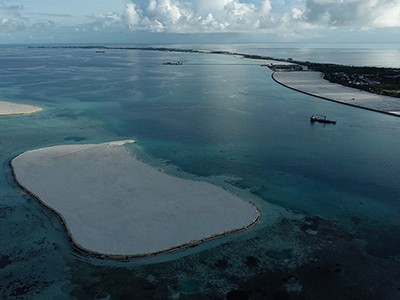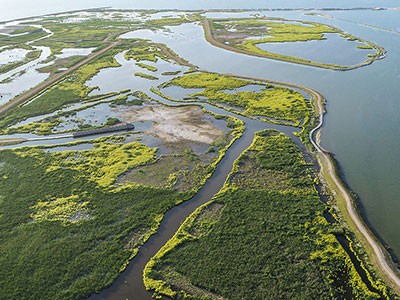Sea levels are changing rapidly and could rise by 1 metre or more by 2100 without drastic reductions in greenhouse-gas emissions1. Low-lying coastal areas — home to nearly one billion people — are at high risk of erosion and flooding2. In July, for example, torrential rain, coupled with high tides and worsening erosion, inundated coastal areas in Lagos, flooding around 2,000 properties and displacing residents across the Nigerian metropolis3.
For coastal communities, urban planning and smart technologies are key to climate adaptation and mitigation. Futuristic designs for flood-resilient settlements, or ‘climatopias’, are gaining popularity, especially in areas projected to be underwater in a few decades4. These large infrastructure projects are being touted by governments and developers as tools to expand the availability of housing, reduce pressures on land, enhance energy efficiency, promote eco-friendly transportation and lessen the effects of flooding. Critics view them as technological fantasies aimed at growing the value of the property market near oceans, lagoons and rivers.
The Maldives is racing to create new land. Why are so many people concerned?
They also note that climatopias could stifle sustainable adaptations — and we agree that this is a real concern. With the right approach, however, they can be made viable. It is crucial that governments, scientists, environmentalists, think tanks, local communities and ocean-governing agencies evaluate the challenges and benefits of these projects in the short and long term to determine their legitimacy as climate solutions.
Here we offer six criteria by which to assess climatopias during their planning and implementation stages: design type, practicality, ecosystem effects, maladaptation risk, justice concerns and regulatory frameworks.
Choose suitable designs
The idea of living on water is not new. It has been traced back to around ad 700 during the Tang Dynasty in China5. On Lake Titicaca in Peru, the Indigenous Uros People have long settled on artificial islands made from roots and reeds6. Homes and villages on stilts are widespread, from Ha Long Bay in Vietnam to Chong Kneas in Cambodia, Ganvie in Benin7 and Makoko in Nigeria8. Amsterdam, Jakarta, Mexico City and Seattle in Washington have long embraced houseboats and floating markets.
Unlike the infrastructure in such traditional communities, climatopias are designed to be high-tech cities equipped with solar panels for generating electricity, deep-sea cooling systems, health-care centres, schools, recreational areas and businesses9. There are three major ways in which developers are converting ocean and near-shore areas into habitable spaces.
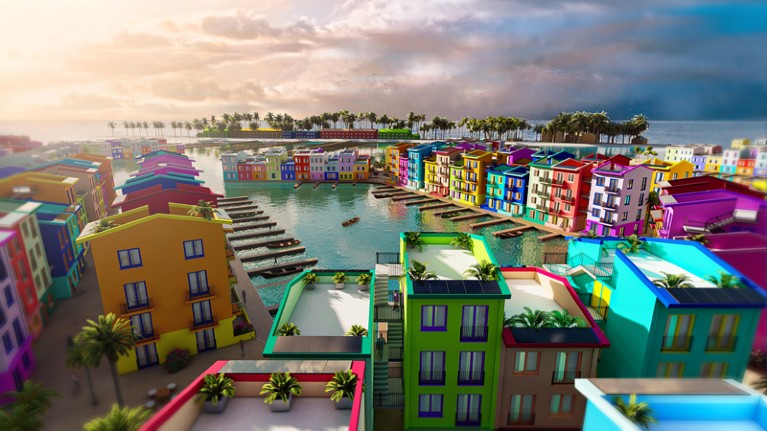
An artist’s impression of a floating city that is being built in the Maldives.Credit: Waterstudio – Dutch Docklands Maldives
Reclaimed land. These structures involve depositing vast amounts of dredged sand, clay, cement or rock into the ocean to make new land that is suitable for construction. Coastal land has been reclaimed in around 50 countries10. Examples include Ocean Flower Island near Danzhou, China; Pearl Island in Doha11; Oxagon city in Neom, Saudi Arabia; and Eko Atlantic in Lagos. These climatopias have iconic architectures that are designed to attract attention and billions of dollars in transnational investment. Some offer tax incentives and relaxed regulations. Criticisms include their impacts on the environment and on nearby communities.
Amphibious houses. These dwellings are anchored to the ground and buoyed by water (see ‘Go with the flow’). This makes them suitable for construction on shorelines, rivers, floodplains and city harbours or other areas with water levels that rise and fall slowly and predictably12. Europe hosts many amphibious communities12,13 — an example is the IJburg neighbourhood of Amsterdam, which is built on artificial islands and is home to around 45,000 people. Scaling up such projects, however, might encourage people to move into high-flood-risk zones when relocation elsewhere could be safer.
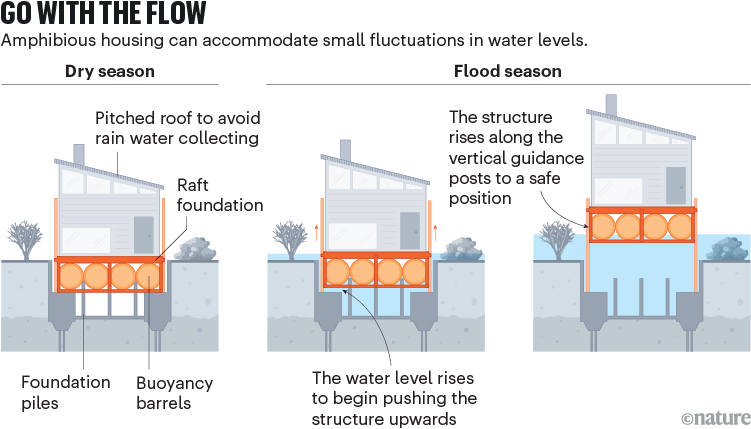
Source: Adapted from H. Ameh et al. Sustainability 16, 1069 (2024).
Floating cities. These watertight, prefabricated structures are situated permanently on the ocean or in lagoons through interlocking modular systems and artificial reefs. The United Nations is urging collaboration between governments, the public and the private sector to advance such cities in at-risk places. For instance, the Maldives Floating City is designed to house 20,000 residents, in units that cost around US$250,000 each, and the Panama floating pods — small structures that each house two people — cost between $295,000 and $1.5 million. Although the first pod sank rapidly during its unveiling, the Panama project has been reconstructed and is now available to investors, visitors and buyers. The long-term sustainability of floating cities and their capacity to withstand major storms is unclear, however.
Assure practicality
Planners, engineers and environmental specialists must assess the construction materials, structural integrity, safety, cost, market demand and financial sustainability of climatopia projects.
Rewilding the planet: how seven artificial islands could help a dying Dutch lake
Amphibious climatopias are relatively cheap. Their proximity to land allows for easy access to electricity, fresh water and waste disposal, which can reduce maintenance costs12. Reclaimed islands, which demand extensive engineering work and lengthy construction times, are the costliest option9. The Ocean Flower Island reclamation project, completed in 2020, took 12 years to build and cost $25 billion. Floating cities need less upfront investment — the one in the Maldives is expected to cost $1 billion, for example — but their maintenance costs can be relatively high, and construction materials are prone to corrosion and damage from tidal waves.
All climatopias are vulnerable to extreme weather — from storms and tsunamis to hurricane-induced flooding — with significant risks of damage and loss of life. To address these problems, governments, planners, insurance companies and affected communities must work together to set industry standards as well as design early-warning systems and evacuation procedures.
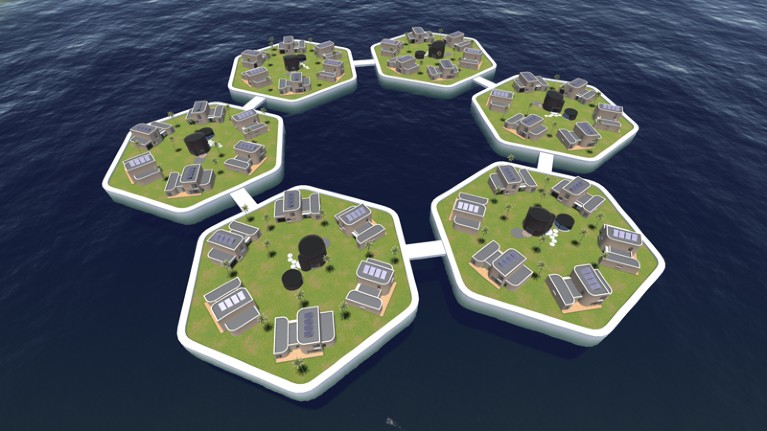
Floating cities are designed to rise with tides and floods.Credit: Ian Burr, Emory Center for Digital Scholarship
Safeguard ecosystems
Construction of reclaimed islands can cause and exacerbate ocean acidification and loss of biodiversity and coral reefs. Dredging of the sea bed degrades marine environments and pollutes waters, potentially releasing long-buried toxic compounds14,15.
Land reclamation can deplete natural buffers, such as mangroves and wetlands10, that act as natural carbon sinks and protect against storm surges, waves, erosion and floods16. Sea walls or revetments can alleviate some of the risks, but do not prevent erosion or subsidence16. They can also damage natural ecosystems, while creating a false sense of security that discourages long-term sustainable nature-based solutions and planning for relocation9,16.
Amphibious and floating cities can alter local patterns of wind, evaporation, sunlight and heat. Increased noise and pollution from such projects can negatively affect fish, crustaceans, molluscs and plant life13. For example, although amphibious houses such as those in Harnaschpolder and IJburg in the Netherlands have not affected water quality, they have contributed to urbanization, generated noise and disturbed aquatic ecosystems13. To reduce the impact on marine life, projects in the Maldives and OCEANIX Busan in South Korea propose to use an artificial reef material known as biorock that supports aquatic organisms.
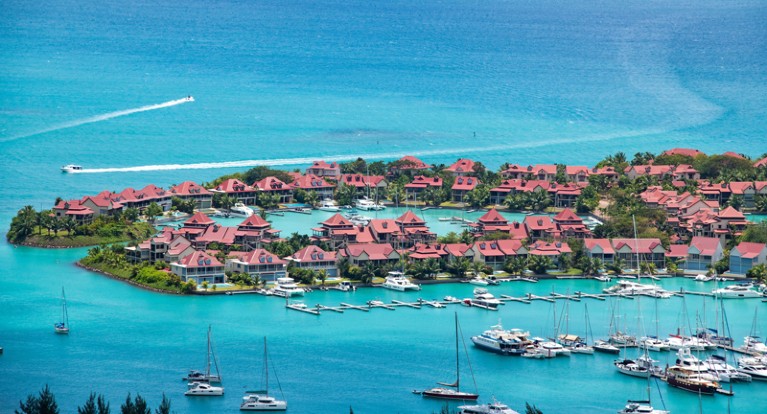
Like many reclaimed lands, Eden Island in the Seychelles hosts luxury properties.Credit: David South/Alamy
To mitigate other environmental impacts, scientists, local communities, residents and non-governmental organizations must demand that urban planners and developers make rigorous and independent environmental and socio-economic assessments. They should insist on transparency in the dissemination of findings. Academics, environmental watchdogs and the media can also improve public awareness about a project’s merits and demerits.
Beyond public scrutiny, government and independent agencies must track and monitor the safety of these projects and their compliance with environmentally sustainable standards. This should include tracking construction materials from source to site, mandating the use of reused or recycled materials, promoting periodic risk assessments and implementing protective measures to safeguard against ecosystem impacts.
Alleviate maladaptation
Bringing people and economic activity that would have otherwise been in rural or suburban locations to a coastal area accelerates greenhouse-gas emissions and environmental degradation, even if energy-efficient systems are used. For example, Eko Atlantic was built on millions of cubic metres of dredged sand and had thousands of tonnes of boulders and stones transported to the project site — processes that release carbon9. Furthermore, paving over natural surfaces can exacerbate erosion and coastal flooding, worsening communities’ existing vulnerabilities.
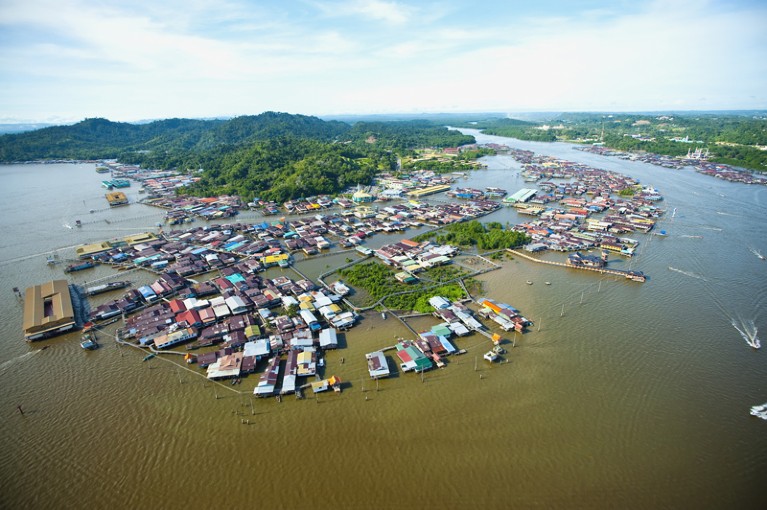
Brunei’s capital city, Bandar Seri Begawan, has long had an aquatic district.Credit: David Kirkland/Design Pics Editorial/Universal Images Group/Getty
Floating cities might need extra energy to maintain infrastructure for water desalination and waste treatment. And those facilities can fail. Insurance and repair costs would place a financial burden on residents and governments, potentially diverting resources from other adaptation measures. To address these pitfalls, governments must update local adaptation plans. They must also invest in social services and crucial infrastructure, especially in low-income areas that are experiencing extreme and frequent flooding.
Prioritize equity and justice
Climatopias often cater to wealthy people. For example, an average unit in Ocean Flower Island reportedly cost $3,100 per square metre in 2019; homes in the Maldives Floating City are expected to start at $250,000. These costs are prohibitively high for most local populations.
Furthermore, the new land and properties are usually privately owned. Rights can be curtailed for the public to access lands and waters that might have been used previously for activities such as fishing or recreation. This can lead to a new form of ocean and land colonialism that perpetuates socio-economic inequalities and increases capital accumulation by powerful groups.
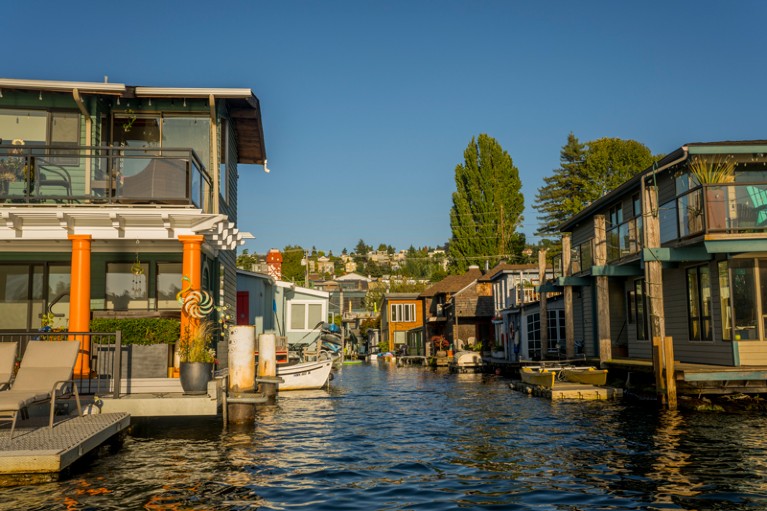
Some residents of Seattle, Washington, have settled in houses built on its lake.Credit: Wolfgang Kaehler/LightRocket/Getty
For example, the building of Eko Atlantic has coincided with severe floods. Some local residents have said they attribute these to the land reclamation activities9. As a result of the flooding, many low-income communities faced losses of lives, homes and livelihoods, or had to move away, while property prices soared in the area. Higher-income communities were mainly in areas that were protected by a sea wall9. The Neom mega-city project in Saudi Arabia has also come under criticism, including from UN experts.
Governments need to revisit ocean and land rights. Economic growth must not be prioritized at the expense of social justice or cultural identity. Collaborative governance frameworks — in which local communities, environmental justice advocates and concerned stakeholders can participate in decision-making with developers and government agencies — must be adopted to promote fair and just planning processes and outcomes.
Tighten regulations
Climatopias are often built in ecologically fragile areas with few regulations. In the United States, for example, guidance on the construction and maintenance of floating homes exists, but is often not legally binding12.
Space@Sea, a multidisciplinary group consisting of 17 European partners, offers technical guidelines that are applicable to floating cities. These guidelines vary depending on legal status. In the Netherlands, where amphibious communities are well established, technical manuals are available to industry professionals working on floating structures12. And amphibious houses often need to be registered both as ships under maritime law and as homes under property law17. The latter is essential for securing home addresses and insurance.
Floating climatopias situated farther out from the shoreline can have ambiguous legal status, because national regulations do not extend to the high seas17. Multilateral treaties, such as the UN Convention on the Law of the Sea, the International Convention for the Safety of Life at Sea and the Convention on Biological Diversity, offer robust recommendations on sustainable development, marine-environment protection, pollution reduction and the equitable use of marine resources. However, these frameworks have not been ratified by all countries and the laws do not cover floating cities, which are relatively new structures on the ocean. Although the International Maritime Organization has no enforcement power, states comply with the agency’s proposed regulations for their mutual benefit. Similar approaches and regulatory regimes will be required as human habitation expands on the sea.
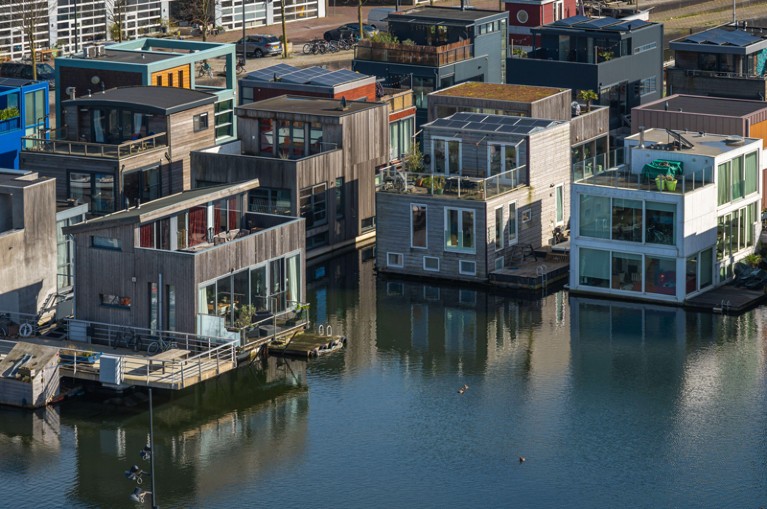
Amphibious houses are widespread in the Netherlands.Credit: Milos Ruzicka/Alamy
The UN must consider reconstituting the mandate of the International Maritime Organization to include floating cities or set up an international agency that would develop clear guidelines and standards for establishing floating climatopias. This agency would be geographically representative and include expertise from diverse disciplines and communities.
Governments must consider environmental, social and intergenerational justice concerns, and protect not just affected communities and ecosystems, but also future generations. Where damages are inevitable, reparation funds for biodiversity and ecosystem restoration should be generated by taxing developers, tourists and investors who benefit from these projects.
Sustainable small-scale fisheries can help people and the planet
Where regulations are lacking, governments must establish zoning laws, building codes and safety protocols, and update them every four years to reflect the latest scientific projections on sea-level rise and flood risks. Residents will also benefit from real-time data monitoring, green building certifications and disaster-risk mitigation plans.
Developers should be mandated to include affordable housing for low-income groups, such as workers and teachers, displaced residents and fishing communities who opt for waterfront living.
No single climate-adaptation strategy will work for all communities. An adaptive coastal future requires flexibility and openness. Floating cities or amphibious houses could be part of climate adaptation for some riverine areas and archipelagos; Indigenous communities might make use of them to stop their heritage, identity and islands from vanishing. Other communities might prefer to retreat from the coast.
Ultimately, climatopias can become technical solutions to a complex global challenge only if stricter planning processes, impact assessments, ecosystem protection and justice for communities are at the heart of any coastal future.


